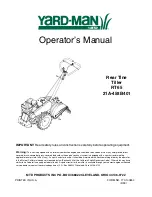
YORK INTERNATIONAL
58
The Suction Pressure Safety Cut-out is programmable
by the user (Page 48). An example of a suction pres-
sure fault message is shown below.
Oil Pressure Safety
The Oil Pressure Safety assures that the compressors
mechanical components receive proper lubrication. The
micro begins monitoring compressor oil pressure after
4 seconds of operation. For operating periods of 4 sec-
onds to 30 seconds, oil pressure must be greater than
5 PSID. From 30 seconds to 240 seconds, oil pressure
must be greater than 20 PSID. After 240 seconds, oil
pressure must be greater than 25 PSID for as long as
the compressor continues to run. If the required oil pres-
sure limits are not met, the system will shut down.
The micro computes differential oil pressure by mea-
suring oil pump pressure and subtracting suction pres-
sure (Oil - Suction = Oil PSID).
An example of an oil pressure fault display message is
shown below:
Discharge Pressure Safety
The Discharge Pressure Safety assures that the sys-
tem pressure does not exceed safe working limits which
could open a relief valve or other pressure relief device
causing refrigerant loss.
This safety is a back-up for the mechanical safety in
the system. Anytime the cut-out point is exceeded, the
system will shut down.
The Discharge Pressure Safety Cut-out is program-
mable by the user (Page 45). An example of a discharge
pressure fault display message is shown below:
NOTE: This safety is only operable if optional discharge
pressure transducers are installed.
Pumpdown Safety
The Pumpdown Safety assures that a compressor does
not run unless it completes a proper pumpdown. This
prevents operation of a refrigerant system which has a
leaking liquid line solenoid valve.
On start-up, the system must pump down to the suction
pressure cut-out within 300 seconds or the system will
shut down.
An example of the Pump down fault display message is
shown below:
NOTE: LLSV refers to liquid line solenoid valve.
Motor Protector
Three internal temperature sensors are built into the
motor stator. These sensors are wired into the motor
protector module located inside the Motor terminal box.
As the motor windings heat and cool, the resistance of
the motor temperature sensors will change. If the wind-
ings overheat, the change in resistance in the sensors
will be sensed by the Motor protector module. The mod-
ule will open its MP contacts breaking the 115VAC fed
to the motor contactor. When the motor contactor de-
energizes, motor current falls to zero. The low motor
current is sensed by the microprocessor and the sys-
tem is shut down. For more information, see MOTOR
CURRENT SAFETY (Page 57).
Auto-restart will be permitted after a shutdown, when
the motor sensors cool and the MP contacts close. A
fault lock-out will result if safety thresholds are exceeded
three times in a 90 minute period.
Mechanical High Pressure Cut-out (HPCO)
A mechanical high pressure cut-out is located on each
compressor discharge or in the compressor head. This
is the primary high pressure safety in the system. Any
microprocessor controls are secondary.
Anytime discharge pressure exceeds 405 PSIG, the
contacts in the high pressure cut-out will open which
removes 115 VAC from the motor protector module.
When 115 VAC control power is lost to the module, the
modules MP contacts open breaking the 115 VAC fed
to the motor contactor. The motor contactor de-ener-
gizes and motor current falls to zero. The low motor
current is sensed by the microprocessor and the sys-
tem is shut down. For more information see MOTOR
CURRENT SAFETY (Page 57).
Auto-restart will be permitted after a shutdown when
discharge pressure drops to below 330 PSIG which al-
lows the mechanical high pressure cut-out to reset and
its contacts to close. This re-applies 115VAC to the
motor protector closing the MP contact. A fault lock-out
will result if safety thresholds are exceeded three times
in a 90 minute period.
S Y S # 1
L O W
S U C T I O N
S Y S # 2
L O W
S U C T I O N
S Y S # 1
L O W
O I L
P R E S S
S Y S # 2
L O W
O I L
P R E S S
S Y S # 1
H I G H
D S C H
S Y S # 2
H I G H
D S C H
S Y S # 1
L L S V
N O T
O N
S Y S # 2
L L S V
N O T
O N
















































